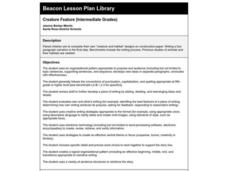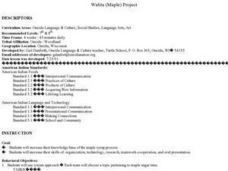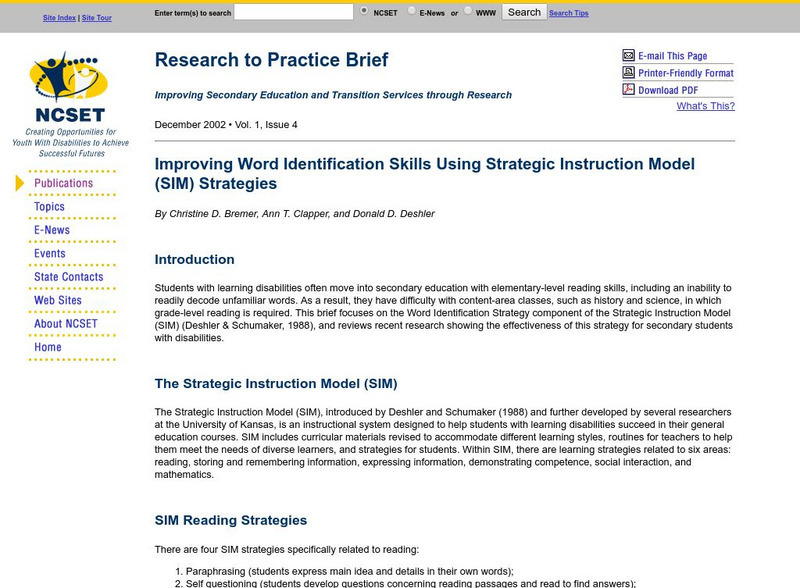Curated OER
Seeing Is Believing
Middle schoolers research and describe the stories of Thomas Jefferson, Meriwether Lewis and William Clark. They analyze historical sources from different points of view and present an analysis of two historical contexts.
Curated OER
What Kind of Reader Are You?
High schoolers write a personal reading history about how reading has influenced their lives. They identify their strengths, weaknesses, and preferences as readers through a survey. Students examine what goes on in their minds while they...
Curated OER
The Great Depression and Now: The Migrant Worker Experience
Young scholars identify the concerns of people caught in desperate times during the Great Depression. They make connections between The Grapes of Wrath and historical images from the Great Depression. Students make connections between...
Curated OER
Language Arts: Two Specific Documents
High schoolers are able to read and analyze the essential parts of two specific types of documents, the informed consent document and the position paper, used by scientists to communicate information about their research to two different...
Curated OER
Let the Good Times Roll! with Louisiana Music
Seventh graders examine the role of the different types of music originating in Louisiana. Using the information they gathered, they create a PowerPoint presentation about an artist who plays Louisiana music. They compare and contrast...
Curated OER
Creature Feature
Students work in pairs to create a creature and its habitat out of construction paper. Then students write a narrative to describe the animal and its habitat.
Curated OER
Place Values and Patterns, What is the Value?
First graders discover the significance of a number's place value by interactively engaging patterns and two-digit place values. For this mathematics lesson, 1st graders complete a 10 by 10 grid to create a number puzzle.
Curated OER
What Has Happened Here?
Learners read a passage from Geraldine Brooks's novel Year of Wonders. They generate questions to clarify the meaning of the text and make connections between the text and information learned in their history and science classes.
Curated OER
Introduction to the Computer
Students visit the computer lab to learn the parts of the computer and type their names and their lunch numbers.
Curated OER
An Amazing Story
Students develop sequential stories to guide a partner through a computer-generated maze. In pairs they illustrate each place and character listed, build and print a maze, and write a class-generated story.
Curated OER
We Thank You, Veteran!
Fifth graders use information from videos, picture books, and relatives' military backgrounds to write a short or extended message of gratitude on a greeting card for local veterans.
Curated OER
Graphs Galore
Fourth graders conduct surveys to collect data. They analyze and interpret the data, then determine which type of graph is appropriate for the data. Students use the data to make predictions, discover patterns and draw conclusions...
Curated OER
Create a Soil Aggregate
Students simulate the conditions which occur in a soil aggregate. They explain how IPM affects the environment. They identify the cast of characteristics to develop their aggregate.
Curated OER
Tree Lesson
Pupils compare and contrast characteristics of conifer and hardwood trees. After collecting samples of branches around the school, they classify the branch as hardwood or conifer. Groups of students identify given twigs. They go...
Curated OER
Using Your Senses
Students use their senses to make observations. In this senses lesson plan, students investigate unknown substances by using their senses for observations. Students identify the number of the substances used, the color, the odor, the...
Curated OER
Charlie and the Chocolate Factory
Eighth graders read and discuss Charlie and the Chocolate Factory. Then they invent a candy bar, name it and draw a picture of it. Finally, they write a short descriptive paragraph about it.
Curated OER
Wahta (Maple) Project
Learners increase their knowledge base of the maple syrup process and increase their skills of organization, technology, research, teamwork-cooperation, and oral presentation. Students use a team approach to choose a topic pertaining to...
Other
How to Study: A Word Identification Strategy
Learn eight steps to help you identify unfamiliar words.
ReadWriteThink
Read Write Think: Word Recognition Strategies Using Nursery Rhymes
This lesson is a great way to teach students about rhymes and word recognition. This plan includes suggest nursery rhymes for you to use, and several supplementary sites to help you out.
Other
Improving Word Identification Skills Using Strategic Instruction Model (Sim)
This research article is a Publication of the National Center on Secondary Education and Transition. In this article, the authors share the steps for using the Strategic Instruction Model (SIM) to help secondary students with identifying...
Education Place
Houghton Mifflin: Eduplace: Word Recognition Skills and Strategies
Included is a brief article outlining the skills that readers, all educational levels, use when they identify printed words. This site contains background material only and no related activities.
ReadWriteThink
Read Write Think: Reading Word Family Words
The focus of the instruction of identification strategies in this lesson plan is the book "Click, Clack, Moo: Cows That Type." Included in the lesson plan is an overview, practice, objectives, resources, preparation, and more.
Free Reading
Free Reading: Connect 4 Words: Letter Sound Accuracy Activity
A reading game based on "Connect 4" that will build student's abilities to say the name and sound of a letter and find a word beginning with that sound.
ReadWriteThink
Read Write Think: Let's Read It Again: Comprehension Strategies for Ell's
Help Spanish-speaking English-language learners unlock the mysteries of their new language by using a bilingual book to recognize unfamiliar words and construct meaning from the text.























